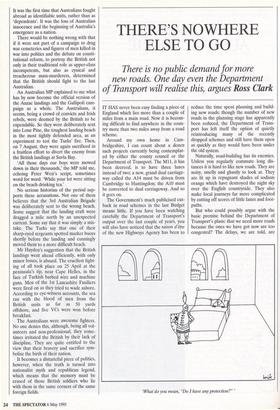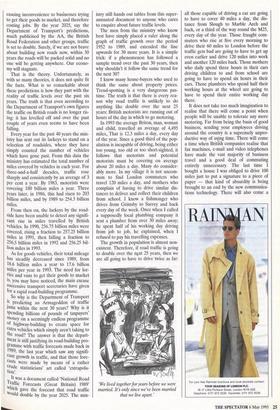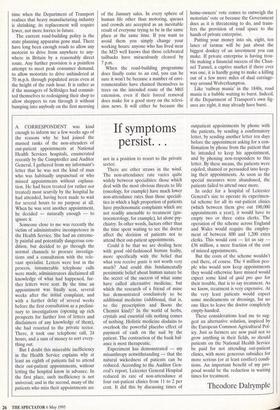THERE'S NOWHERE ELSE TO GO
There is no public demand for more new roads. One day even the Department
of Transport will realise this, argues Ross Clark IT HAS never been easy finding a piece of England which lies more than a couple of miles from a main road. Now it is becom- ing difficult to find anywhere in the coun- try more than two miles away from a road scheme.
Around my own home in Cam- bridgeshire, I can count about a dozen such projects currently being contemplat- ed by either the county council or the Department of Transport. The M11, it has been decreed, is to have three lanes instead of two; a new, grand dual carriage- way called the A14 must be driven from Cambridge to Huntingdon; the A10 must be converted to dual carriageway. And so it goes on.
The Government's much publicised cut- back in road schemes in the last Budget means little. If you have been watching carefully the Department of Transport's output over the last couple of years, you will also have noticed that the raison d'être of the new Highways Agency has been to reduce the time spent planning and build- ing new roads: though the number of new roads in the planning stage has apparently been reduced, the Department of Trans- port has left itself the option of quietly reintroducing many of the recently dropped schemes and still have them open as quickly as they would have been under the old system.
Naturally, road-building has its enemies. Unless you regularly commute long dis- tances it is hard to like new roads. They are noisy, smelly and ghastly to look at. They are lit up in repugnant shades of sodium orange which have destroyed the night sky over the English countryside. They also make local journeys far more complicated by cutting off scores of little lanes and foot- paths.
But who could possibly argue with the basic premise behind the Department of Transport's plans: that we need more roads because the ones we have got now are too congested? The delays, we are told, are 'What do you mean, "Do I have any protection?" ' causing inconvenience to businesses trying to get their goods to market, and therefore costing jobs. By the year 2025, say the Department of Transport's predictions, much publicised by the AA, the British Road Federation and other groups, traffic is set to double. Surely, if we are not brave about building new roads now, within 30 years the roads will be packed solid and no one will be getting anywhere. Our econo- my will stagnate.
That is the theory. Unfortunately, as with so many theories, it does not quite fit the facts. What is so remarkable about these predictions is how they part with the reality of traffic levels over the past six years. The truth is that even according to the Department of Transport's own figures the traffic on British roads is no longer ris- ing: it has levelled off and over the past couple of years even seems to have been falling.
Every year for the past 40 years the min- istry has sent out its lackeys to stand on a selection of roadsides, where they have simply counted the number of vehicles which have gone past. From this data the ministry has estimated the total number of miles covered by vehicles in each year. For three-and-a-half decades, traffic rose sharply and consistently by an average of 3 per cent a year. By 1983, motorists were covering 180 billion miles a year. Three years later, in 1986, this had risen to 203 billion miles, and by 1989 to 254.3 billion miles.
From then on, the lackeys by the road- side have been unable to detect any signifi- cant rise in miles travelled by British vehicles. In 1990, 256.75 billion miles were covered, rising a fraction to 257.25 billion miles in 1991, then falling a fraction to 256.5 billion miles in 1992 and 256.25 bil- lion miles in 1993.
As for goods vehicles, their total mileage has steadily decreased since 1989, from 18.6 billion miles a year to 17.6 billion miles per year in 1993. The need for lor- ries and vans to get their goods to market is, you may have noticed, the main excuse successive transport secretaries have given for a rapid road-building programme. So why is the Department of Transport is predicting an Armageddon of traffic Jams within the next 30 years? Why is it spending billions of pounds of taxpayers' money on a seemingly endless programme of highway-building to create space for extra vehicles which simply aren't taking to the road? The answer is that the depart- ment is still justifying its road-building pro- gramme with traffic forecasts made back in 1989, the last year which saw any signifi- cant growth in traffic, and that those fore- casts were made by means of a rather crude statisticians' art called 'extrapola- tion'.
It was a document called 'National Road Traffic Forecasts (Great Britain) 1989' which gave the forecast that road traffic would double by the year 2025. The min- istry still hands out tables from this super- annuated document to anyone who cares to enquire about future traffic levels.
The men from the ministry who know best have simply placed a ruler along the graph of traffic growth over the period 1952 to 1989, and extended the line upwards for 30 more years. It is a simple trick: if a phenomenon has followed a sample trend over the past 30 years, then why shouldn't it follow the same trend for the next 30?
I know many house-buyers who used to think the same about property prices. Trend-spotting is a very dangerous pas- time. The truth is that there is every rea- son why road traffic is unlikely to do anything like double over the next 25 years: British motorists are running out of hours of the day in which to go motoring.
In 1993 the average Briton, man, woman and child, travelled an average of 4,495 miles, That is 12.3 miles a day, every day of the year. Since a good third of the pop- ulation is incapable of driving, being either too young, too old or too short-sighted, it follows that motorists and potential motorists must be covering on average about 20 miles a day. Many do consider- ably more. In my village it is not uncom- mon to find London commuters who travel 120 miles a day, and mothers who complain of having to drive similar dis- tances to deliver and collect their children from school. I know a fishmonger who drives from Grimsby to Surrey and back every day of the week. Once when I called a supposedly local plumbing company it sent a plumber from over 30 miles away; he spent half of his working day driving from job to job, he explained, when I refused to pay his travelling expenses.
The growth in population is almost non- existent. Therefore, if road traffic is going to double over the next 25 years, then we are all going to have to drive twice as far: 'We lived together for years before we were married. It's only since we've been married that we live apart.' all those capable of driving a car are going to have to cover 40 miles a day, the dis- tance from Slough to Marble Arch and back, or a third of the way round the M25, every day of the year. Those fraught com- muters who rise at five every morning to drive their 60 miles to London before the traffic gets bad are going to have to get up even earlier and drive 120 miles into work and another 120 miles back. Those mothers who daily spend three hours in their cars driving children to and from school are going to have to spend six hours in their cars. Those plumbers who spend half their working hours at the wheel are going to, have to spend their entire working day there.
It does not take too much imagination to realise that there will come a point when people will be unable to tolerate any more motoring. Far from being the basis of good business, sending your employees driving around the country is a supremely unpro- ductive way of using time. There will come a time when BritM companies realise that fax machines, e-mail and video telephones have made the vast majority of business travel and a good deal of commuting entirely unnecessary. The last time I bought a house I was obliged to drive 100 miles just to put a signature to a piece of paper — that kind of absurdity is being brought to an end by the new communica- tions technology. There will also come a time when the Department of Transport realises that heavy manufacturing industry is shrinking; its replacement will require fewer, not more lorries in future.
The current road-building policy is the state planning apparatus gone mad. There have long been enough roads to allow any motorist to drive from anywhere to any- where in Britain by a reasonably direct route. Any further provision is a pointless attempt to meet peak consumer demand, to allow motorists to drive unhindered at 70 m.p.h. through populated areas even at the height of the rush hour. It is rather as if the managers of Selfridges had commit- ted themselves to redesigning their shop to allow shoppers to run through it without bumping into anybody on the first morning of the January sales. In every sphere of human life other than motoring, queues and crowds are accepted as an inevitable result of everyone trying to be in the same place at the same time. If you want to avoid them you simply change your working hours: anyone who has lived near the M25 well knows that those celebrated tailbacks have miraculously cleared by 7 p.m.
When the road-building programme does finally come to an end, you can be sure it won't be because a number of envi- ronmentalists have chained themselves to trees on the intended route of the M65 extension, even if their forced removal does make for a good story on the televi- sion news. It will either be because the home-owners' vote comes to outweigh the motorists' vote or because the Government does as it is threatening to do, and trans- fers the provision of road space to the hands of private enterprise.
Putting your money into six, eight, ten lanes of tarmac will be just about the biggest donkey of an investment you can make. If private enterprise is having trou- ble making a financial success of the Chan- nel Tunnel, a captive market if there ever was one, it is hardly going to make a killing out of a few more miles of dual carriage- way around Wolverhampton.
Like 'railway mania' in the 1840s, road mania is a bubble waiting to burst. Indeed, if the Department of Transport's own fig- ures are right, it may already have burst.




































































 Previous page
Previous page